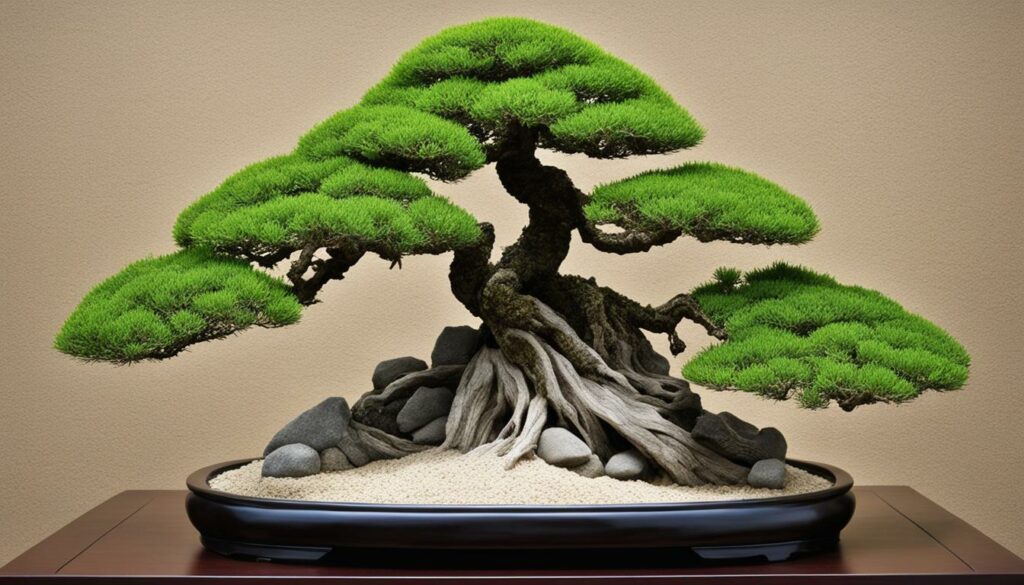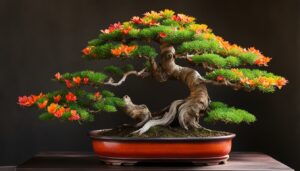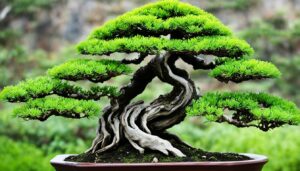Bonsai styling display and presentation techniques are essential to showcasing the beauty and intricacy of these miniature trees. When presented correctly, a bonsai tree can captivate its audience and convey its rich history and significance. In this article, we will explore a range of presentation techniques and showcase tips that will help you create captivating exhibitions with perfect aesthetics, whether you are showcasing your bonsai trees at home, in exhibitions, or for commercial purposes.
Key Takeaways:
- Mastering bonsai styling, display, and presentation techniques is crucial to showcasing the beauty and intricacy of these miniature trees.
- Selecting the right display stand, creating a balanced composition, and incorporating natural elements can significantly enhance the visual appeal of bonsai presentations.
- Incorporating seasonal changes and capturing bonsai in photography are additional techniques to make your exhibition stand out.
Choosing the Right Display Stand
When it comes to displaying your bonsai tree, choosing the right display stand is critical for showcasing the tree’s beauty. Your display stand should complement the tree’s style and personality and create a captivating visual presentation.
Consider the following factors when selecting a display stand for your bonsai:
- Size: Choose a stand that is proportional to your bonsai tree’s height and width. A stand that is too small can make your tree appear cramped, while a stand that is too large can overpower the tree’s delicate features.
- Material: Display stands are typically made of wood, metal, or concrete. Each material offers unique characteristics that can enhance your tree’s visual appeal. For example, a wooden stand can provide a warm, organic feel, while a metal stand can add a modern touch.
- Aesthetics: Your display stand should reflect your tree’s personality and style. Consider the style of your bonsai and the environment you want to create. A formal, symmetrical tree would pair well with a simple, elegant stand, while a wild, informal tree would look better with a natural, rugged stand.
Most Common Bonsai Display Stand Materials
| Material | Characteristics |
|---|---|
| Wood | Warm, Organic, Elegant |
| Metal | Modern, Sleek, Industrial |
| Concrete | Durable, Heavy, Masculine |
Choosing the right display stand can be a daunting task, but with careful consideration of these factors, you can create a stunning presentation that showcases your bonsai tree’s natural beauty.
Creating a Balanced Composition
When it comes to bonsai styling display, achieving visual harmony is key. Creating a balanced composition involves careful consideration of the tree’s placement, accent pieces, and other elements. Here are some tips to help you create a beautifully balanced bonsai display:
Consider the Tree’s Placement
The tree should be at the focal point of the display, with other elements arranged around it. Place the tree slightly off-center to create interest and visual movement. A good rule of thumb is to position the tree to the right or left of center, rather than in the middle. This will create a natural flow and prevent the display from looking static.
Use Accent Pieces
Accent pieces are essential for creating a visually interesting display. Choose items that complement the tree and add interest without overpowering it. Experiment with different types of accent pieces, such as rocks, ceramics, or small statues. Make sure they blend in harmoniously with other elements of the display.
Choose the Right Container
The container is an important aspect of the display and can have a significant impact on the overall aesthetics. When selecting a container, consider the tree’s size and style and choose one that enhances these features. A container that is the right size and shape will make the bonsai look more natural and harmonious.
Add Color and Texture
Adding color and texture to the display can enhance its beauty and add depth. You can achieve this by adding moss, flowers, or other plants to the display. Choose colors and textures that complement the tree and accent pieces, creating a cohesive and eye-catching composition.
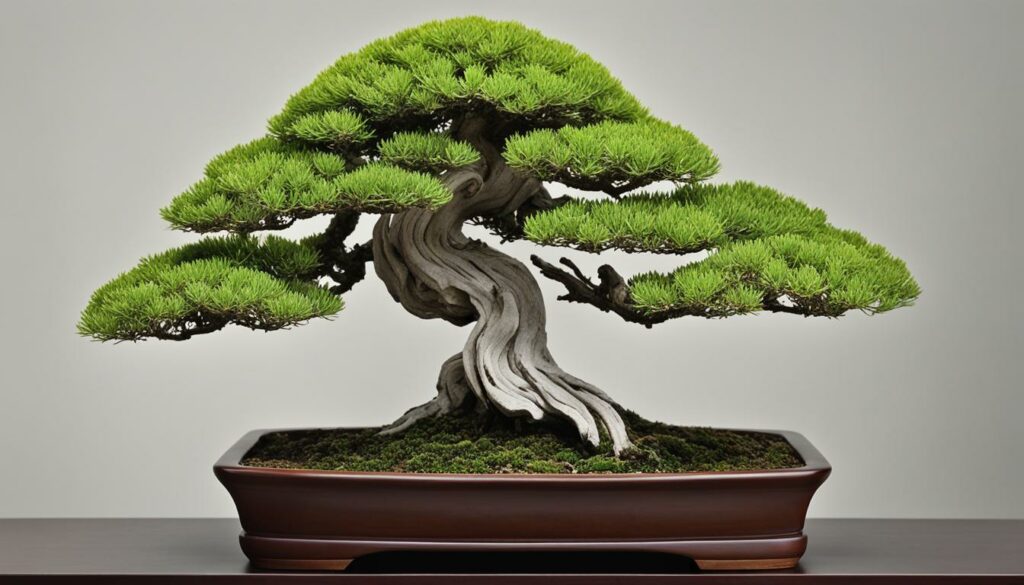
“A balanced composition can make the difference between an ordinary display and an extraordinary one.”
Utilizing Backgrounds and Lighting
Backgrounds and lighting play a crucial role in creating a visually appealing display for your Bonsai trees.
When choosing a background, keep in mind that it should complement the tree, not overshadow it. Natural settings such as rock formations, waterfalls, and gardens can help create a serene landscape, connecting the tree with its natural surroundings. Alternatively, you can choose a neutral-colored screen or cloth that does not take away from the Bonsai’s beauty. Additionally, you can use different textures of paper, fabric, or even other bonsai trees to create a layered look and add depth to your display.
Lighting is another crucial element as it helps highlight the tree’s best features. A good tip is to use natural light wherever possible. Placing the Bonsai tree near a window or in an outside garden can provide natural light that showcases its beauty. However, if the natural lighting is not an option or if the display is at night, you can use artificial lighting to highlight specific areas of the tree or create different visual effects.
Tip: When using artificial lighting, ensure that the light does not directly hit the tree as it may cause damage to the leaves and bark. Instead, position the light source at an angle to create a soft and elegant display.
Various lighting fixtures such as spotlights, LED lighting, and floor lamps are available that cater to Bonsai displays. You can use them to create a different mood, highlight specific highlights, or enhance the display. However, keep in mind that the brightness, angle, and color of light should be relevant to the tree’s aesthetics and not cause distraction.
In conclusion, backgrounds and lighting play a significant role in Bonsai styling display. By utilizing the right lighting and background, you can create a stunning display that showcases the Bonsai’s beauty to the best effect.
Accentuating Color and Texture
When it comes to bonsai styling display, color and texture are two important features that you should consider. Both of these elements help to emphasize the beauty of your tree and add to its aesthetic appeal. To accentuate these aspects, choose plant combinations that complement each other and create an interesting contrast. For example, if you have a bonsai with needle-like leaves, pair it with a plant sporting large and glossy leaves. This will help to showcase the texture of both the plants better.
Another valuable tip is to incorporate flowering plants in your display to add a pop of color. Choose flowers that complement the color of the leaves in your bonsai as this will create a harmonious look. Use your creative side, and do not shy away from experimenting with different plant combinations to achieve the desired results.
When choosing a bonsai pot, consider the color of the glaze, and complement it with the plant’s foliage to create an overall balance. It is essential to maintain the balance across the different elements in your display, including the bonsai tree, the accent plant, and the pot, to avoid a cluttered look.
Remember, a visually appealing bonsai display is more appealing to the eye and will attract attention to your bonsai. Ensure that you have a variety of plants with different sizes, shapes, and colors to create a visually interesting display.
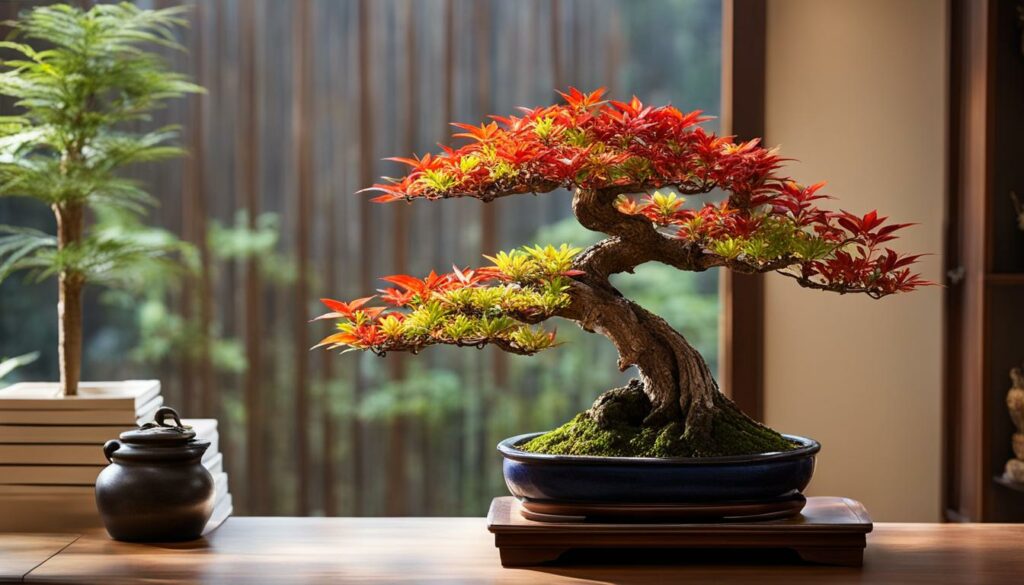
Incorporating Natural Elements
Creating a visually pleasing bonsai display involves more than the tree itself. Incorporating natural elements like rocks, moss, and water features can add an extra level of interest to your presentation.
For instance, placing a few carefully arranged stones around the base of your bonsai tree can give the impression of it being part of a natural landscape. Similarly, carefully positioning a small fountain or water feature near your display can add movement and tranquility to the surroundings.
When using natural elements, consider how they complement the overall aesthetic of your display. For example, using moss to create a ground cover around your bonsai can give the impression of a miniature forest floor. The right combination of natural elements can create an immersive and captivating environment for your tree.
Displaying Bonsai Species Specifics
When displaying your bonsai, it is crucial to showcase the unique characteristics of each species. Taking into account factors like leaf size, trunk shape, and seasonal variations can help you create a startling presentation. Consider planting your trees in accent pots, which complement the characteristics of the tree and visually enhance its features. For example, the delicate leaves of a Ficus Bonsai can be highlighted by placing it in a fine porcelain pot that accents the tree’s elegant nature.
You can also create a sense of balance by arranging accent items the right way. For instance, creating a water feature display with rocks and moss can be an excellent way to complement a tree that has a flowing shape, like a Weeping Willow Bonsai tree. Incorporating shades of green and brown into the background can add depth and texture to your display.
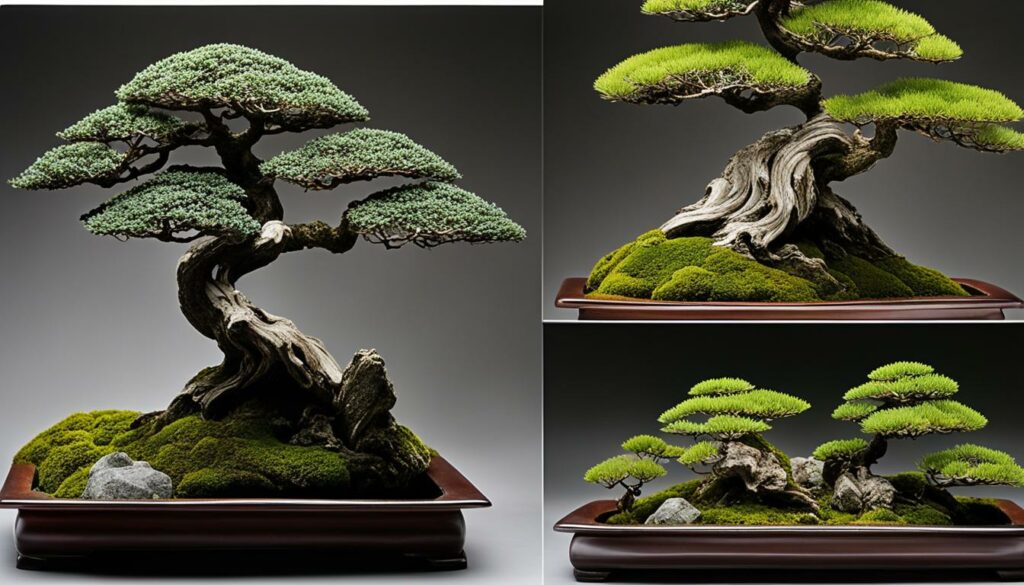
Recommended Trees and Pots
| Bonsai Tree Species | Aesthetic attributes | Recommended Pot Material |
|---|---|---|
| Sakura Bonsai | Spring flowering, pink blossoms | Ceramic |
| Juniper Bonsai | Evergreen, rugged texture | Unpolished granite |
| Maple Bonsai | Colorful foliage, changing with the seasons | Hand thrown clay pot |
By using the right techniques and materials, you can highlight the beauty and unique features of each bonsai species, making your display a reflection of the meticulous art of bonsai styling.
Creating Dynamic Display Styles
When it comes to displaying your bonsai trees, experimenting with different styles can help you achieve stunning results that highlight the unique beauty of each plant. Some of the most popular display styles include:
- Formal upright: in this style, the bonsai tree stands perfectly upright with a straight trunk and symmetrical branches. It’s ideal for showcasing trees with a classic, restrained aesthetic.
- Informal upright: instead of standing perfectly straight, the trunk of a bonsai tree in this style twists and turns slightly for a more organic, natural look. It’s great for showcasing trees with a wild, untamed beauty.
- Windswept: in this style, the tree appears as if it’s been shaped by harsh winds, with all the branches and foliage angled in one direction. This style is perfect for showcasing trees with a rugged, windswept character.
- Cascading: in this style, the tree’s branches bend downward, creating a waterfall effect. It’s ideal for showcasing trees with a cascading character, like the Japanese maple.
These styles can be adapted and combined to create fascinating new display arrangements that showcase your bonsai trees in the best possible light. Just remember to always prioritize the changing needs and aesthetics of your bonsai when making your display decisions.
Preparing for Bonsai Exhibitions
If you’re a bonsai enthusiast, you know how important it is to prepare your trees properly for exhibitions. Your beautiful trees deserve to be showcased in the best possible way, and a little preparation can go a long way in achieving that.
One of the most crucial things to keep in mind is the grooming of your bonsai tree. Make sure it’s neat and tidy, with all the unwanted leaves and branches carefully cut away. Use a pair of sharp scissors or shears and take care not to damage the tree while pruning.
It’s also important to ensure the tree is healthy and in optimal condition. Inspect your tree carefully for pests and diseases and take the necessary steps to address any issues. Water and fertilize your tree as required, and monitor its growth carefully to ensure it’s at its best.
Transporting your bonsai tree can be tricky, but it’s necessary to take it to the exhibition venue. Use a sturdy box or container that can hold the tree safely in place during the journey. Avoid exposing the tree to extreme temperatures or harsh conditions that can damage it.
Finally, take some time to plan your display. Choose an appropriate backdrop and accent pieces that complement your tree’s aesthetic. Decide on the right lighting to showcase your tree in the best possible way. A little attention to detail can make a world of difference in presenting your bonsai in the most visually appealing manner.
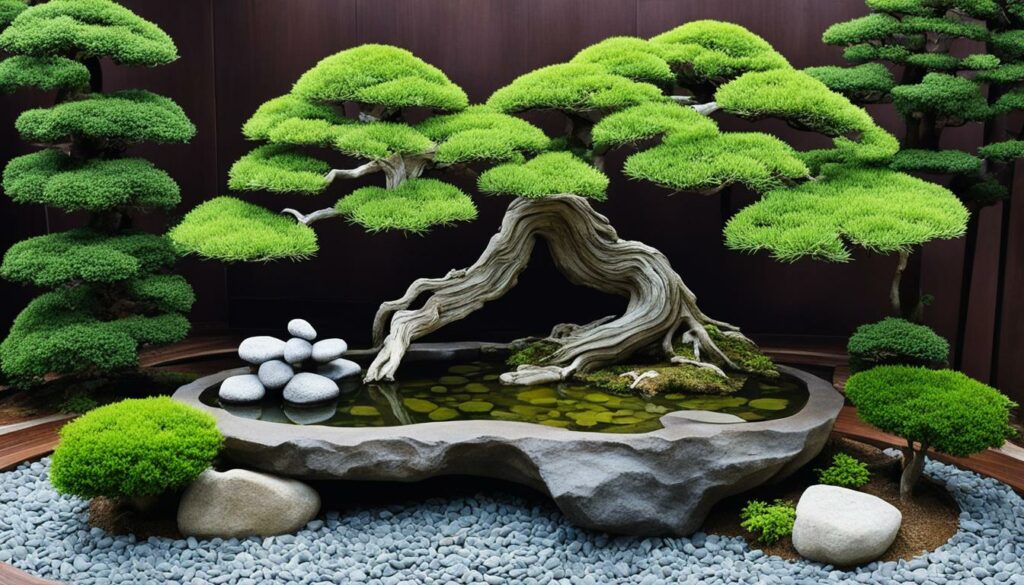
“Bonsai exhibitions provide a wonderful opportunity to showcase your trees and see what others are doing in the world of bonsai. With a little preparation, you can take advantage of this opportunity to make a lasting impression.”
Arranging Bonsai Exhibition Spaces
When arranging bonsai exhibition spaces, it’s essential to consider the flow of the exhibition and the visitor experience. Here are some tips to ensure a smooth and engaging event for all.
Layout
Think about the layout of the exhibition space and how visitors will navigate the area. Consider creating different zones to showcase different categories of bonsai, such as species, styles, or sizes. Use signage to guide visitors throughout the space and highlight particular trees or areas of interest.
Crowd Management
Managing crowds is crucial during bonsai exhibitions to ensure visitors can view and appreciate the trees while maintaining a safe distance. Consider limiting the number of people in the exhibition space at any given time. You could also set designated viewing areas for popular trees to avoid congestion and improve flow.
Signage
Proper signage can help visitors understand the trees better and appreciate the details. Display informational signs with the tree’s name, species, style, and other relevant information. You could also use QR codes for visitors to scan and learn more about the tree or the exhibition in general.
| TIP | The placement of your bonsai within the exhibition space can affect the overall aesthetics. Strategically place trees of varying heights and colors to create a visually appealing and balanced presentation. |
|---|
Keep in mind that the exhibition space should reflect the quality of the trees on display. Ensure it’s clean and well-lit with appropriate lighting that highlights the trees’ colors and textures.
By arranging the exhibition space carefully, you can create a memorable and engaging event that showcases the beauty and artistry of bonsai.
Showcasing Bonsai Seasonality
Bonsai trees are living art that beautifully exhibit the seasonal changes of nature. Incorporating this seasonality into your displays can add a touch of realism and freshness that captures the observer’s eye. To adjust your exhibitions according to the climate and weather changes, you need to know which species of bonsai to choose and how to use creative props, foliage, or flowering patterns.
For example, during the spring season, you can decorate your exhibition table with eye-catching cherry blossom bonsai trees. You can also add a touch of pink or white flowers to the table, matching the colors and energies of spring. During fall, you can use yellow and orange foliage and line up your table with maple bonsai trees. This will create an overall warm and inviting ambiance in your exhibition space.
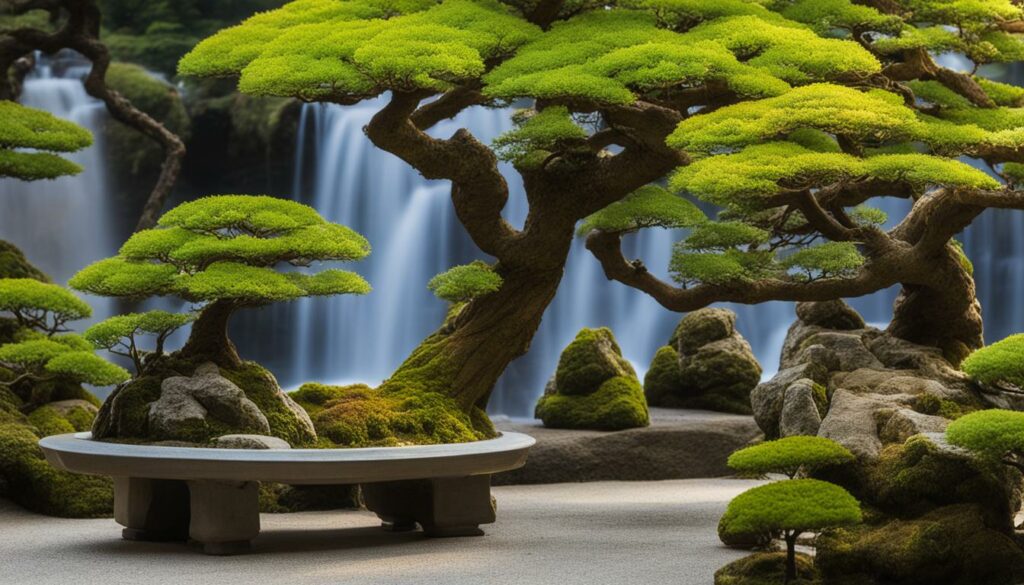
Using the right color scheme and props will create a visually appealing tableau, which can help you showcase your bonsai’s artistic seasonal changes. Your creativity can be complemented by using different textures and materials, such as moss, stones, and sand, providing a natural and complementary background for the bonsai’s display. When curating an event or show displaying multiple bonsai trees, you might want to group them according to seasons and symmetry or by complementary colors or textures, creating a magnificent seasonal display for all.
Capturing Bonsai in Photography
When showcasing your bonsai at an exhibition, it’s essential to capture these miniature masterpieces in high-quality photographs to showcase their beauty even after the event has ended. Whether you’re using a professional DSLR camera or your smartphone, here are some showcase tips to help you take stunning photos of your bonsai trees:
- Consider the angle: Experiment with different angles to find the best view of your bonsai. Try getting low to the ground for a unique perspective or shooting from above to capture the entire tree.
- Play with lighting: Good lighting can make or break a photo. Natural light is ideal, but if you’re indoors, use soft lighting to highlight your tree’s features.
- Show the essence of your bonsai: A great photo tells a story. Try to capture the essence of your bonsai by emphasizing its unique characteristics and capturing a sense of peacefulness or strength.
Remember that practice makes perfect, so take as many photos as you can and experiment with different techniques to find what works for you. And don’t forget to showcase your beautiful bonsai photos with pride!
Conclusion
Now that you’ve learned about the art of displaying bonsai, you can enhance your presentation techniques and showcase your miniature trees in the best possible way. Perfecting your bonsai styling and display skills is essential to creating captivating exhibitions that leave a lasting impression on your audience. Remember the importance of choosing the right display stand, creating a balanced composition, utilizing backgrounds and lighting, accentuating color and texture, incorporating natural elements, showcasing bonsai species specifics, creating dynamic display styles, preparing for bonsai exhibitions, arranging exhibition spaces, showcasing seasonality, and capturing bonsai in photography.
By mastering these skills, you can create an exhibition that showcases your bonsai tree’s beauty and enhances its natural features. Your visitors will appreciate the care and attention you’ve put into the presentation. So, start practicing and experimenting with different techniques to create stunning bonsai displays that truly impress. Good luck with your bonsai styling display and presentation journey!
FAQ
What are some important presentation techniques for displaying bonsai?
Important presentation techniques for displaying bonsai include choosing the right display stand, creating a balanced composition, utilizing backgrounds and lighting, accentuating color and texture, incorporating natural elements, showcasing bonsai species specifics, creating dynamic display styles, preparing for bonsai exhibitions, arranging bonsai exhibition spaces, showcasing bonsai seasonality, and capturing bonsai in photography.
How do I choose the right display stand for my bonsai tree?
When choosing a display stand for your bonsai tree, consider factors like the size of the tree, the material of the stand, and the aesthetics you want to achieve. The stand should enhance the overall presentation of the bonsai and complement its style and characteristics.
What does creating a balanced composition in bonsai display involve?
Creating a balanced composition in bonsai display involves arranging the tree, accent pieces, and other elements in a way that achieves visual harmony. Consider factors like the placement of the tree within the display space, the use of negative space, and the overall balance of the design.
How can I utilize backgrounds and lighting to enhance the presentation of my bonsai tree?
Utilizing backgrounds and lighting can significantly enhance the presentation of a bonsai tree. Choose a background that complements the tree and creates a visually pleasing contrast. Experiment with different lighting techniques to highlight specific features and create the desired atmosphere.
How can I accentuate color and texture in my bonsai display?
To accentuate color and texture in a bonsai display, carefully choose plant companions that complement the colors and textures of the bonsai tree. Consider contrasting foliage colors, different leaf textures, and interesting shapes to create visual interest and depth.
What natural elements can I incorporate into my bonsai display?
You can incorporate various natural elements into your bonsai display, such as rocks, moss, and water features. These elements can enhance the natural beauty of the bonsai and create a more immersive and captivating presentation.
How can I showcase the unique characteristics of different bonsai species in my display?
To showcase the unique characteristics of different bonsai species, consider factors like leaf size, trunk shape, and seasonal variations. Arrange the tree and its accompanying elements in a way that highlights these specific traits and celebrates the natural beauty of each species.
What are some dynamic display styles I can explore for my bonsai?
There are various dynamic display styles you can explore for your bonsai, such as formal upright, windswept, and cascading. These styles can add visual interest and drama to your bonsai presentation, showcasing the tree in different artistic interpretations.
How do I prepare my bonsai for exhibitions?
To prepare your bonsai for exhibitions, focus on grooming, pruning, and maintaining the optimal health and appearance of the tree. Pay attention to details like removing dead branches, maintaining a clean pot, and ensuring the overall aesthetic quality of the bonsai.
How should I arrange my bonsai exhibition space?
When arranging your bonsai exhibition space, consider aspects like the layout of the trees, the placement of signage and information boards, and the flow of visitors. Aim to create a visually pleasing and engaging experience for the attendees while ensuring the safety and accessibility of the exhibition space.
How can I incorporate the seasonal changes of bonsai trees into my displays?
To incorporate the seasonal changes of bonsai trees into your displays, consider using props that reflect the corresponding season, choosing foliage that changes color or blooms during specific times, and creating arrangements that evoke the mood and essence of each season.
What tips can you provide for capturing stunning photographs of bonsai trees?
To capture stunning photographs of bonsai trees, pay attention to angles and composition, experiment with lighting to highlight specific features, and aim to capture the essence and unique characteristics of each bonsai. Use techniques like depth of field and selective focus to create visually impactful images.
